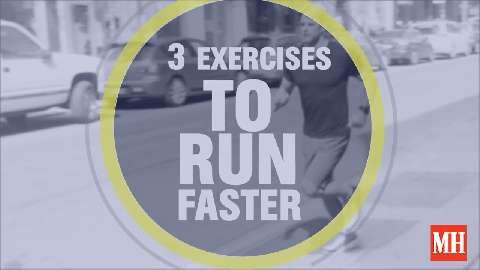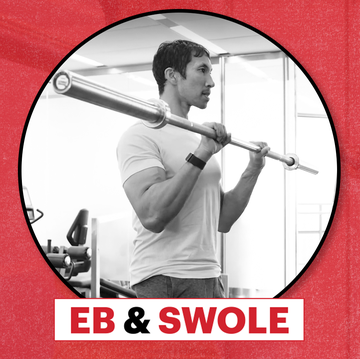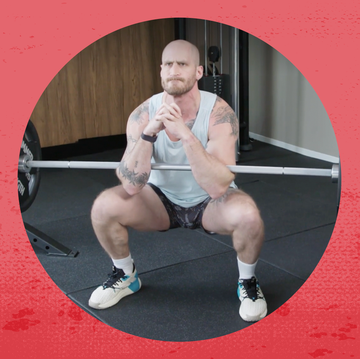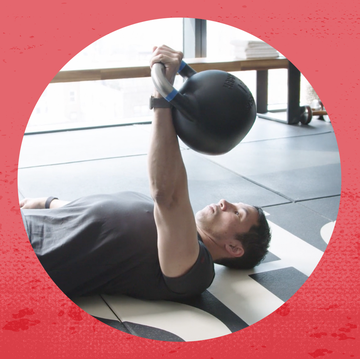American soldiers have been doing a simple fitness activity since the American Revolution, and it’s turned our military into the fittest, most feared fighting force in the history of the world.
That activity: rucking, or walking with a weighted pack on your back.
The activity gets its name from “ruck sacks,” which is military speak for “backpack.” “Rucking” is marching or walking while wearing your ruck sack (which is always loaded down with gear).
In training camps and in the field, soldiers may ruck up to 25 miles (or more) a day, grunting a pack that weighs upwards of 200 pounds.
But to build the body of a Navy SEAL, you don’t have to (nor should you) carry a pack weighing the equivalent of grown man. Just add a bit of weight to any old pack you have lying around the house, take a walk, and you’ll open up a whole new world of fitness. (Here are 4 More Daily Exercises Every Navy SEAL (and Every Fit Guy) Should Do.)
“Rucking is great for the average person,” says Doug Kechijian, Doctor of Physical Therapy at Peak Performance, in New York City, and a former US Special Forces soldier. “It’s simple, and it delivers a lot of health and fitness benefits.”
It Crushes Calories
For the average guy, a 30-minute walk burns about 125 calories, according to the Compendium of Physical Activities. But throw a weighted backpack on and take that exact same walk, and you burn about 325 calories, also according to the Compendium of Physical Activities.
Just wearing a backpack with some weight in it makes walking incinerate nearly three times the calories!
Think about that. Let’s assume you take three, 30-minute walks each week. If you begin wearing a weighted pack, you’ll burn 31,200 more calories over the course of a year. That’s the amount of calories contained in nine pounds of fat.
“Rucking will make you look better, no doubt,” says Dan John, a famed strength coach located in Salt Lake City, Utah, and the author of Can You Go? “It’s especially great for fat loss.”
It Can Relieve and Prevent Back Pain
If you work out, you will probably experience back pain at some time. Why?
You probably spend a significant portion of your day sitting, with your back flexed forward. You get “used” to that position.
Then, when you hit the gym, if you lift with your back flexed it can cause a potentially-painful disc bulge, says Stu McGill, Ph.D. professor of spine biomechanics at the University of Waterloo in Ontario and the author of Ultimate Back Fitness and Performance.
People who have developed a disc bulge often lean forward when walking. This makes your situation worse, because your body has to fire your back muscles even harder to hold your torso up. “That puts more stress on the disc bulge,” says McGill.
Throwing a weighted backpack on and going for a walk actually helps hold your torso up, so your back muscles don’t have to work as hard.
“The net effect is that less compression is put on your spine, and the flexed forward posture that inflames the disc is reduced,” says McGill. “And it can also work disc gel (a disc bulge is caused by extruded disc gel) back into the middle of your disc, reducing the bulge."
That, in turn, can help prevent and relieve your pain.
(To protect your back even more, do The Fit Man’s Back-Saving Workout)
It Builds Your Endurance—Safely
Rucking turns your lazy walk into a heart health boosting endurance endeavor.
“The cardio benefits of rucking are comparable to those gained from other long, slow distance exercises like jogging,” says Jason Hartman, C.S.C.S. who trains Special Forces soldiers for the US Military.
But unlike jogging—which has an injury rate anywhere from 20 to 79 percent, according to a study in the British Journal of Sports Medicine—rucking actually makes you more injury resilient, says Hartman.
“It builds up your hip and postural stability, and that makes you more injury proof in all your other activities,” he says.
Related: 10 Exercises That Burn More Calories Than Running
It Makes You Better In The Gym
“Rucking is the holy grail of work capacity,” says John.
Learning to effectively cover ground under load is often the missing link that can be a game changer for your fitness level, he says. “Carrying heavy things is a fundamental human skill that most people don’t train.”
It builds you a more solid foundation of fitness, says John. “And once you build the foundation, everything else becomes easier.”
Yes, many exercises build work capacity. But John likes this one because it safely works your endurance while under load.
It’s Easy (And Inexpensive) To Do
Maybe every morning you and the dog take a walk, or you commute to work on foot, or you consistently go for a post-dinner stroll.
From now on, simply wear a backpack with some weight in it when you do those everyday activities. Simple, right?
What’s more, most new fitness methods require that you buy expensive equipment, gym memberships, or workout programs.
Not so with rucking. You probably already have a backpack and something you could use for weight lying around your house.
Related: The 70 Best Bodyweight Cardio Exercises
It Gets You Out Of The Gym
Let’s face it, your average gym workout can become arduous. And once your routine becomes routine, you stop caring and your fitness plateaus.
Rucking gets you outside, walking in nature. That’s not only a welcome change, it can also reduces stress—according to British research—and may help you sleep better at night, according to the National Sleep Foundation.
Outdoor exercise also throws something new at your brain.
“Modern life overemphasizes convergence. We stare at computers, cell phones, and TV screens all day and never let go,” says Kechijian. “Rucking outside, having to read terrain and adapt works your brain in a totally different way, and that can provide positive changes in your brain.”
How To Do It
1. Choose your load
A good place to start for general fitness is to use a weight that’s equal to about 10 percent of your total bodyweight, says Kechijian. For example, if you weigh 150 pounds, load your pack with about 15 pounds.
Don’t stress too much about going above or below by a pound or two—just stay in the general ballpark.
Once you’re comfortable, you can progress up to 35 pounds, says John.
“You can go with 35 pounds on your back for days, months, years,” he says. “But once you start to sneak above 35 pounds, it can break down your body.”
2. Load the pack
For weight, you could throw a dumbbell in your pack. Or you can even use a couple of bricks or a sand bag.
If you feel like getting fancy, various online sites offer weight plates specifically designed for rucking.
Wrapping a towel or bubble wrap around your weight will help to stabilize it, so it doesn’t shift around in the bag.
You can use any backpack you have lying around, but if you plan on using 35 pounds regularly, invest in pack designed to hump serious weight. We like the options from GORUCK and Camelbak, both of which are up to military specifications.
3. Ruck!
Now, toss on your pack and go for a walk or hike. You can go as long and far as you want. But when you’re just starting, it’s best to ease into the activity.
“Afterwards, you’ll probably be sore in some places your normal fitness routine has ignored,” says John. “Expect the muscles around your knees, your butt, and your low back to be tender. The upside is that the pack puts you into appropriate posture, so you’re working muscles that need working.”
Bonus
If you want to ruck with a lot of people or increase the challenge, GORUCK—a gear and event company started by Special Forces veterans—hosts hundreds of rucking events across the country. Those range from 6, 12, 24, and 48-hour military-style challenges, to distance-based group rucks.













